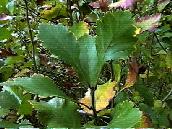

Black Hawthorne
Crataegus douglasii
var.
rivularis Nutt.
Deciduous native, grows as a small tree (20-30 feet tall), or smaller thicket-forming shrub (10 feet tall), with sharp, single spines, thorns, up to one inch long. Leaves are alternate, 1½ - 4 inches long, generally oval, and serrated on the outer half of the leaf. Small white, 5-petaled flowers (about ½ inch in diameter), with an unpleasant smell, appear in spring in clusters. It flowers from May to June, and produces black berries by August. the New twigs often turn reddish in early summer. Grows on well-drained foothills, mountains, or subalpine slopes. Can also be found in dry to moist areas, especially on the edges of pastures along streams in well-drained, sandy or gravelly soils. Grows best in full sun to partial shade and forms dense thickets. Found throughout the North West and in southeastern Idaho. Reported by Nuttall in rivulets along the Rocky Mountains.
Food Uses:
The fruit may be eaten, but is rather seedy and
tasteless. After the seeds are removed it may be used, cooked or mashed,
for cakes in berry bread or in soups. The berries may also be steeped to
make teas, drinks, or the juice used make wine.
Medicine Uses:
Hawthorne is best known for it use in herbal medicine its positive effects on
the heart. It can be used for high blood pressure and to slow the heart
rate. The effects are gradual and it must be taken regularly for an
extended period to be effective. As a tea it can also be used to treat
kidney disease and nervous conditions. It is often included in weight loss
programs.
Value for Wildfire:
Forage production is usually low from Douglas hawthorn thickets. Stands may
be so dense as to preclude most livestock use. Douglas hawthorn thickets
produce an abundant amount of food and cover for wildlife species. Dried fruits
and stems provide autumn food for frugivorous birds such as blue and
sharp-tailed grouse in Washington and Idaho.
Douglas hawthorn has good structural diversity, and provides both thermal and hiding cover. Birds such as magpies and thrushes are especially attracted to Douglas hawthorn for cover and nesting due to its thick, intricate branching. Avian use is heaviest during the nesting/brooding season, and at the time of fruit ripening. During the winter, Douglas hawthorn continues to provide dense escape cover. Black-billed magpie nests are built mainly in Douglas hawthorn crowns, and long-eared owls will build their nests atop magpie nests. Small mammals also use Douglas hawthorn stands for cover. Rickard [32] found deer mice and long-tailed voles living in Douglas hawthorn thickets.
Planting:
Grow from seed or salvage. Seed should be collected as soon as it ripens
(late July through August), because it is harvested quickly by birds. Separate
seeds from pulp and sow seeds immediately in trays containing ordinary soil. Sow
very thickly, because some seeds may not germinate until the second spring, and
place the trays in an unheated area. Seed not planted in the fall needs to be
cold-stratified for 2½ months to break seed dormancy. Plants quickly develop a
long taproot, so they should be transplanted into a permanent location as soon
as possible. Will grow up to two feet per year in the first couple years.
Grows best with sun and moist soils.